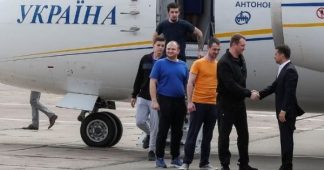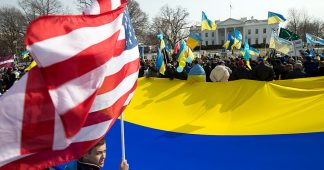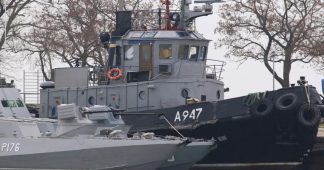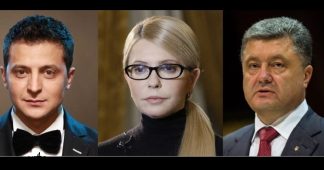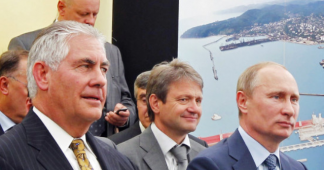By Eric Zuesse
Nov. 2, 2019
Clear and convincing evidence will be presented here that, under U.S. President Barack Obama, the U.S. Government had a detailed plan, which was already active in June 2013, to take over Russia’s main naval base, which is in Sevastopol in Crimea, and to turn it into a U.S. naval base. There can now be no question that the war in Ukraine started, and resulted from, the U.S. Government’s plan to take over all of Ukraine, and especially to take over that Russian naval base, in Crimea, which then was in Ukraine.
The war in Ukraine didn’t start at the time when a lot of people think that it did, with the overthrow of Ukraine’s President Viktor Yanukovych. It was already underway considerably before that time, because it started in Washington, as the folloowing masterful 11-minute documentary makes clear — it started as a subterranean war by Washington to take over Ukraine, before it became an overt war (a “civil war”) within Ukraine:https://www.youtube.com/watch?
The CIA-edited and written Wikipedia claims that the war commenced in “a series of military actions that started in February 2014”; and, that, from the outset, it has been a “Russian military intervention in Ukraine (2014–present)” — not any sort of American intervention in Ukraine. However, to the extent that Russia has been involved in the Ukrainian war, that involvement came later, and was a reaction against what the U.S. Government and its agents had done to Ukraine (which nation is, of course, on Russia’s doorstep, and so Russia inevitably did respond). Therefore, the propagandistic function of Wikipedia must be acknowledged, even though Wikipedia is adequate for providing an introductory overview of some non-geostrategic subjects.
The U.S. regime, under Barack Obama, had been planning, ever since June 2011, a takeover of Ukraine, in order to become enabled ultimately to place its nuclear missiles within less than five minutes flying-time to a first-strike blitz destruction of the Kremlin (thus preventing any effective Russian counter-attack). However, things didn’t work out quite according to the plan for the takeover of Ukraine, and here is how the war in Ukraine actually began:
We’ll open by describing the planning for the conquest of Russia’s key naval base, in Sevastopol in Crimea. Crimea was inside Ukraine during 1954-2014, but had otherwise been inside Russia, going all the way back to 1783. (During 1954, the Soviet dictator, Khrushchev, arbitrarily transferred Crimea, from Russia to Ukraine, even though the vast majority of Crimeans considered themselves to be Russians, and their native language was Russian — but, after all, the Soviet Union was a dictatorship. Crimeans had no say in the matter.)
The U.S. regime prepared for its planned takeover of Crimea by commissioning Gallup to poll Crimeans in 2013 to find out whether the residents there considered themselves to be Ukrainians (which would make the U.S. regime’s job in Crimea easier), or instead still Russians (which would foretell resistance there); and the findings were that Crimeans overwhelmingly still considered themselves to be Russians, definitely not Ukrainians. Nonetheless, the plan for the takeover went forward — the U.S. team, it is clear, decided that the residents of Crimea could be dealt with, in such ways as is shown here:https://www.youtube.com/watch?
Some were clubbed to death, others became permanently disabled from their injuries, but this was a warning to Crimeans, to buckle under, and give up: be ruled from Kiev, by Washington’s regime. It didn’t work. A referendum was quickly held in Crimea about whether they wanted to be ruled by the newly installed Ukrainian government, and the results were in line with Gallup’s findings: Crimeans wanted to be ruled from Moscow, not from Kiev.
The U.S. then hired Gallup to survey Crimeans soon after the referendum. (Perhaps the U.S. regime was hoping to find that a scientific sampling of Crimeans would show a far smaller percentage favoring the breakaway of Crimea from Ukraine than the referendum had reported, which could greatly intensify international skepticism about the legitimacy of Russia’s takeover of Crimea. But, if that was the purpose, Gallup’s findings again turned out to be a disappointment.)
Here is what Gallup found in both its 2013 and 2014 polls of Crimeans:
When Gallup did their “Public Opinion Survey Residents of the Autonomous Republic of Crimea May 16-30, 2013” (which was called that because even when Crimea was part of Ukraine, it had a special status, as being an “Autonomous Republic” — not a province), only 15% (slide 8) of Crimeans viewed themselves as “Ukrainian,” but 40% said “Russian,” and 24% said “Crimean.” 53% (slide 14) wanted Crimeans to be part of the “Customs Union with Russia, Belarus and Kazakhstan,” but only 17% wanted Crimeans to be part of “The European Union.” 68% (slide 15) said their feelings toward “Russia” were “warm,” but only 6% said their feelings toward “USA” were “warm.
When Gallup in April 2014 (right after the referendum) polled Crimeans again (slide 25), 76.2% had a “negative” view of the United States, and 2.8% had a “positive” view of it; 71.3% had a positive view of Russia, and 8.8% had a negative view of it. Asked whether (slide 28) “The results of the referendum on Crimea’s status likely reflect the views of most people there/here,” 82.8% said yes; 6.7% said no. 89.3% in the poll expressed an opinion on this matter, and 93% of those who expressed an opinion said that the referendum “likely did reflect the views” of Crimeans. That was almost exactly the same percentage as those who in the referendum had voted to rejoin Russia. It couldn’t have been stronger verification of the referendum-results, than that. The Gallup poll findings (like its predecessor) were hidden from the public — not broadcast to the public by the regime’s propaganda-media. After all: the U.S. Government is a regime — it’s not a democracy. All of the formalities, now, are just for show. Both of its political parties are imperialists (“neoconservative”). Only their style differs.
So: the U.S. regime knew that it wasn’t, at all, wanted nor welcomed by Crimeans, but that Russia very much was. The U.S. regime thus moved forward on the basis that the government of Ukraine owned that land; the residents who lived there did not, and should have no say about what government owned it and would rule them. The idea was that, if the people there didn’t like it, they should emigrate to Russia (and, according to a Russian source, “4.4 million went to Russia” — removed themselves from Ukraine — after the coup).
The U.S. regime, clearly, wanted the land, not the people who were living on it. The expectation, as soon as Ukraine was under U.S. control from the coup, had been that America would get the entirety of Ukraine, including Crimea; but, then, Russia’s Vladimir Putin stepped in and protected Crimeans who were clamoring to hold a referendum in order to express their collective will on this matter; and this referendum was held, on 16 March 2014, and it produced over 90% voting for Crimea to be a part of Russia, such as Crimea had been before Khrushchev transferred it to Ukraine.
So: the U.S. regime failed to get the naval base that it had expected to get in Sevastopol in Crimea. That was a crucial failure for Obama.
Those events — the coup and, three weeks later, the Crimean referendum — occurred in 2014, but the planning for the coup had already been going on for years, and it wasn’t being called off once Gallup reported in 2013 that most Crimeans loathed the U.S. The active operation to take over Ukraine had started actually on 1 March 2013 inside the U.S. Embassy in Kiev, which was almost 9 months before Ukrainian President Viktor Yanukovych, on 20 November 2013, rejected the EU’s demand that Ukraine must bear the full $160 billion cost of abandoning its existing trading relationships with Russia and its allies, in order to join the EU. Wikipedia says that the overthrow of Yanukovych started on 21 November 2013 when he said no to the EU, but actually it started on 1 March 2013; and the planning for it had started by no later than June 2011. And it may be said to have begun even prior to that, when, near the very start of Obama’s Presidency, Obama called the then-Ukrainian-Presidential-ca
There was no question as to whether Ukrainians wanted to be in NATO: they did not. During 2003-2009, only around 20% of Ukranians wanted NATO membership, while around 55% opposed it. In 2010, Gallup found that whereas 17% of Ukrainians considered NATO to mean “protection of your country,” 40% said it’s “a threat to your country.” Ukrainians predominantly saw NATO as an enemy, not a friend. But after Obama’s February 2014 Ukrainian coup, “Ukraine’s NATO membership would get 53.4% of the votes, one third of Ukrainians (33.6%) would oppose it.” The coup turned what remained of Ukraine sharply against Russia. NATO is the key; the EU is more like an excuse for Ukraine to be admitted into NATO.
In June 2013 (well before the ‘democratic revolution’ in Ukraine started), NAVFAC, the U.S. Naval Facililities Engineering Command, published on its website, a “Project Description” for “Renovation of School#5, Sevastopol, Ukraine,” under the euphemistic title “EUCOM Humanitarian Assistance Program”. EUCOM is the U.S. European Command — it is purely military, not “humanitarian,” at all. The 124-page request for proposals (RFP) showed extensive photos of the existing school, and also of the toilets, floor-boards, and other U.S.-made products, that the U.S. regime was requiring to be used in the renovation (by some American corporation, yet to be determined) of that then-Ukrainian school in Crimea, which at that time was a Ukrainian Government property, not at all American-owned or operated. So: why were U.S. taxpayers supposed to fund this ‘humanitarian’ operation, by the U.S. military?
A remarkably full description, of what that extraordinary RFP was about, was provided on 24 April 2014 by a “Lada Ray,” under the headline “Breaking! US Planned to Turn #Crimea into Military Base Against Russia”, and here is its opening:
—
Breaking! US Planned to Turn #Crimea into Military Base Against Russia
24 April 2014, Lada Ray: A couple of weeks ago Crimea and Sevastopol almost unanimously voted to re-join Russia. The Crimeans said: we had been unappreciated guests, now we are returning home after a long voyage. More about that in my articles:
Why is Crimea Overwhelmingly Pro RE-Unification With Russia?
Prediction: Crimea Independence Vote
The information coming to the surface now shows that if Crimea stayed as part of Ukraine, it would have become a huge NATO/US military base. I seriously doubt that the people of the Crimea would have stood for that, but if such a thing did happen, it would have meant WWIII as Russia would never allow it. From this perspective it’s especially clear why NATO, USA and EU were so shocked that Russia decisively accepted Crimea back. They already considered it theirs.
The city of Sevastopol is the prized possession. This is one of the best harbors in the world. But the entire Crimea is of huge strategic importance – first and foremost, if you want to attack Russia. In addition, Crimea is important for the control over other countries, including Iran and Turkey. As they say, he who controls Crimea, controls the Black Sea.
At least one hospital in Crimea’s capital Simferopol and at least one school in Sevastopol were targeted by the US/NATO just recently. They were planning on turning the hospital into a base for their troops after a massive renovation. One of the high schools (a gymnasium) in Sevastopol the Kiev authorities were about to sell to the US to be repurposed as a school for spies, targeting Russia. It was planned that the kids going to that school would be learning languages and spying techniques since an early age.
It appears Americans wanted to turn the Crimea into a massive military/navy/intelligence complex. The famous, one-of-a-kind Soviet underground submarine base in Balaklava, which is now the Museum of the Cold War, was visited in the past several years by at least 25 delegations from the Pentagon, US Navy, NATO, and Western political circles. Kiev gave them access to super-secret Russian/Soviet sectors of the base, which were supposed to be off limits. They studied with great interest the secret documentation and technology.
In Sevastopol, called “the city of the Russian glory” and the “hero city,” the NATO and US navy ships and military have been present for years. The population greeted them with constant protests, which prevented some of the planned joint military exercises between NATO and Kiev. Sometimes, the NATO ships had to leave because of the population’s resistance (protest footage on video below at 1:54). US/NATO ships in the Sevastopol harbor tried many times to “park” right in front of the Russian ships stationed there just out of spite. As we know, for 23 years, since the breakup of the USSR in 1991. Russia has been leasing its own base on its historic land for $100mln a year from Kiev.
Sevastopol had been the important base of the Russian Fleet since 1776. Sevastopol is a large and beautiful city populated with ethnic Russians, many of whom are retired navy officers and their families. These people dreamed for 23 years of going home – and by home they always meant Russia. Add to that that Kiev constantly attacked Russian language, little by little taking away the right of the Russian-speakers to speak their native language.
In Crimea, the US financed very generously various media, NGOs, and politicians, who would essentially become their agents. Of course, much of that was styled as support for democracy.
People of the Crimea felt deeply insulted by such attitude by the bought-and-paid-for Kiev and such disrespect of their heritage and wishes by the US/NATO.
—
You didn’t see that information in the New York Times, Washington Post, London Times, Telegraph, Guardian, or any other U.S.-regime propaganda-organ; and, so, the facts that are told there might be surprising (or even shocking) to readers under the U.S. regime; but they are true, and the propaganda isn’t.
Then, Ukraine’s far eastern Donbass region, which had voted over 90% for the democratically elected President of Ukraine whom Obama had overthrown, also broke away. Here is how that happened:
Ukraine started its war against resisters by drafting everyone they could grab, and sending them in tanks into the south and east, in order to prevent any more secessions than Crimea had already done. The draftees were terrified, and didn’t want to kill. On 16 April 2014, the Kiev Post bannered “A day of humiliation, as Ukrainian military offensive stalls, six armored vehicles seized”. It opened: “On April 15, Ukraine’s military began an anti-terrorist operation against Kremlin-backed insurgents who have taken over numerous government buildings and police headquarters in several cities of Donetsk Oblast, Ukraine’s most populous region where 10 percent of the nation’s 45 million people live.” The residents in Donbass were now officially (by gther Obama-installed government) called “terrorists,” and Ukraine called its war to exterminate them the “Anti-Terrorist Operation” or ATO. Its objective was to eliminate as many of Yanukovych’s voters as possible (and Donbass having voted over 90% for Yanukovych meant that all of it was now a free-fire zone for Ukraine’s soldiers and bombers), so that the new regime would be able to win future elections (by eliminating the government’s opponents).
On 2 May 2014, thugs who were organized by the newly installed American regime in Kiev burned to death an uncounted number, perhaps over a hundred, individuals inside the Odessa Trade Unions Building, who had been distributing flyers against the coup-regime. Some of the massacre’s key organizers had friends inside the Obama White House. That event set off a panic throughout the eastern and southern half of Ukraine, where Yanukovych had overwhelmingly won the Presidency. The secession movement in the areas where Yanukovych had won (southern and eastern Ukraine), formed, and during 4-9 May 2014 took over some government buildings. Donbass, where Yanukovych had won by over 90%, seceded. The bombings and cannonades against Donbass — and sometimes even firebombings against them— took over.
That’s how the war started.
The U.S. regime and its supporters imposed severe sanctions against Russia for responding.
The accounts that have been given about the Ukrainian war by U.S.-and-allied ‘news’-media have been boldly blatant lies.
